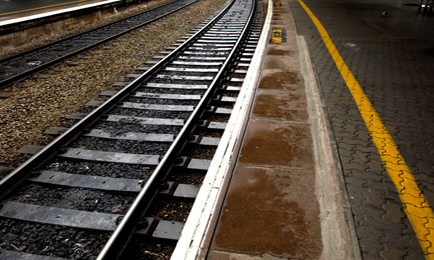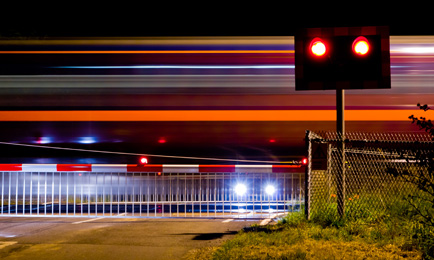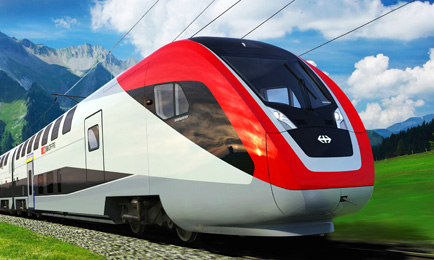Is the driverless car a threat to the railways?
20 July 2015
This article, by Ben Sampson, published in The Institution of Mechanical Engineers magazine, provides a great insight in to the future of the railways based on the speed of technological changes happening in other sectors. As Chris Woodhams, Operations Manager at Argenta comments "automation has been embedded in the rail industry for many years. Taking this to the next level in combination with things like double decker trains and ‘turn up and go’ we will see some interesting technological developments. Cross industry knowledge transfer is something that I don’t think is utilised as much as it should be, but it is a difficult concept to implement effectively".
The enduring memory of the old British Rail advertising slogan “let the train take the strain” evokes images of green and pleasant countryside whizzing past your window. You stretch out to relax, or perhaps hunker over your laptop to work. Then the train runs parallel to a motorway, snarled up in stress-inducing traffic, for a while. You reassure yourself smugly that you made the right decision and consider buying a sandwich from the buffet car.

It’s an over-idyllic vision of rail transport, but it’s a key part of the reason why today more people than ever before choose to travel by train. So much so that at peak times the rail network is stretched to overcapacity in some places. You’re lucky to get onboard, let alone sit down. Railways have a monopoly on high-speed, hassle-free, ‘affordable’ transport for the masses.
Driverless road vehicles could alter this drastically. What if you could walk out of your front door, program your driverless car to take you to your destination, then sit back and do some work, watch a film, even eat a sandwich, in a completely stress-free, private environment? What if you could catch a driverless coach, guaranteed to travel non-stop at high speed as part of a convoy along the M1 to Birmingham or Manchester? Would you still even consider using High-Speed 2?
Hands-free driving
It’s a question that more and more people in the rail sector are asking. When the automotive sector achieves the driverless vehicle – some engineers talk about them being just 10 years away – some of the monopoly that rail has held for the last 200 years on fast ground transport will vanish. Could the driverless car make railways redundant?
Andy Doherty, director of systems engineering at Network Rail, says: “If we do not respond to the threat of the convoyed car and lorry, railways are at risk on the mainline. They aren’t at risk in large conurbations, because the job is slightly different.”
Autonomy was used in railways long before driverless cars were even considered. London Underground’s Victoria Line has featured automatic train operation since it opened in 1967. Trains run automatically from station to station, with the driver responsible for door operation and dealing with emergency situations, such as obstacles on the line. Various autonomous systems have been in use for even longer in the rail sector. For example, the Underground’s Northern Line has had an automatic train timetable system since the 1920s – it runs off a paper roll, and still does today.
Doherty says that the rail sector has been “pretty good” at automating “parts, but not the whole process” of travel. “Our opportunity is to make the whole process intelligent for the customer, to deliver better services at a better price,” he adds.
Network Rail is taking a “layered” approach to increasing automation in its infrastructure and sees it as a key part of its Digital Railway initiative. The first layer aims to develop new ways of collecting data on its assets and then use this information to organise maintenance and renewal better. This ranges from the use of drones for inspection and monitoring to the use of iPads by staff to handle maintenance documentation. The organisation is also working to put measurement equipment from its special track measurement trains on to service trains.

Challenge for automation
A major issue with the increased amount of data collected is its sorting and prioritisation, says Doherty. The job requires a human. Software that automates the process is a clear goal that Network Rail has in common with several other sectors challenged by so-called big data.
The second layer is services. Network Rail hopes to use the same data to improve traffic management, and to help enable the convoying of trains and a moving block control system. The main benefit will be to free-up capacity on the mainlines. “We need convoying in railways now,” says Doherty. “We’re down some of the road with the European Train Control System Level 2, and Global System for Mobile Communications – Railways is now largely running all the trains. Level 3 moving block is train-to-train control. Beyond that we have the uncoupled train.”
The third layer will provide better information to customers. This could be used to affect pricing and manage passenger flow, explains Doherty. Traffic management systems could add another train to a service if there is high demand, then discounted tickets could be offered to encourage passengers from the full service to the extra train. “Why do you need a timetable?” he asks. “Turn up and go should be possible, for example on Woking to London.
“Automation and the digital railway is potentially the biggest change to the mainline coming. Lines like the London to Brighton are running the same timetable as 25 years ago and no one knows how to change it. We’re at the centre of that.”
Another major area where opportunities lie to increase automation is on board the trains themselves. The focus is on the use of mechatronics in areas such as the running gear and pantographs. In particular, the replacement of bogies by a system of actuators and computerised control could speed trains up and reduce rolling resistance by up to 15%. This could treble the life of wheels and rails and reduce maintenance costs by a significant amount, says Doherty.
Eventually, a wheel unit could be used in each corner of the train to create a “virtual bogie”, Doherty says: “Further developments of mechatronic-type technologies may give us the opportunity to redesign bogies and all the running gear to give more space for passengers and reduce the amount of weight, the energy used, and the wear on the rail, and to increase steering capability and speed. Maybe it could bring a double-decker on the UK gauge.
“If you can’t go up, maybe we can go down, remove the bogie, remove a lot of space being used by the engineering capability.
Looking at a train for the 21st century and beyond, we need to take technology forward, work with other sectors, aerospace, automotive, and incorporate what they are doing. As engineers, we have to utilise these opportunities.”
There are opportunities to use automation elsewhere on a train. Andrew Brassington, Bombardier’s head of engineering for single-deck platforms, says the passenger environment, such as the lighting, HVAC and information system, is already automated. “Most of the driver’s task is about train movement, safe arrival and departure, and dealing with degraded modes of operation,” he says. “We are looking at automating some of these tasks on Crossrail with some automatic train moves at terminal stations. HS2 have an aspiration to automate train coupling and uncoupling.”
Driver advisory systems, which give advice on driving the train, have already been developed and could potentially be more automated, says Richard French, project manager for EU-funded research projects at Bombardier.
Another area in which the train manufacturer is looking at increasing automation is maintenance. The company is developing prognostic and diagnostic systems that will enable trains to self-monitor and self-diagnose in real time and automatically flag up when they need maintenance attention.
Slap, bang in the middle of the trains and the track are the control systems, the signalling and communications network. The control system is a crucial part of any autonomous railway.
The Interfleet consultancy has engineers working on a range of autonomous projects for the rail sector. The firm is part of a large research project developing the European Train Control System (ETCS), an improved pan-European signalling system, with automatic train operation (ATO) functionality. It has a team of 50 engineers working on the control systems for Crossrail, Thameslink and HS2.
The first two lines feature a hybrid control system. Outside London, they will use conventional ETCS. In London, where there are more stations, they will switch to ATO to perform more like a metro service. Both Crossrail and the Thameslink upgrade should enter service in 2018. “It’s unique, a first from a controls and operations perspective,” says Matt Phillips, director of rail control systems at Interfleet.
Meanwhile, HS2 plans to be future-proofed for hundreds of years. Phillips says: “It’s a noble ambition, to be not just leading-edge now, but to be engineered so it can be adapted to future needs. Technologies available change relatively fast and will do so in the next 30 years.”
Phillips believes increased autonomy in driving could be one of the changes we see in the near future that HS2 has to cope with. He says: “Driverless vehicles are a significant threat to rail. Within transport control it’s our biggest opportunity and our biggest threat. If we don’t do it quickly the automotive industry will.”
In simple terms, a transport control system for a railway and a road network are fundamentally the same. Synergies between the two can be seen today, in the latest developments in smart road networks, convoying in lorries and guided roadways for buses. Like Doherty, Phillips sees driverless cars as posing the biggest threat to intercity trains: “If you go to the fringes of a city and between them, and you can travel and work in your car with high automated speed limits – that’s a huge threat to intra-urban rail travel,” he says.
But in the middle of cities, where there are a lot of cars, mass transit will still be better. It’s in rail’s favour that we are becoming more urban, more concentrated in the way we live.”
Brassington from Bombardier says that driverless vehicles should increase capacity on roads, but believes that an area where railways have the edge is speed restrictions, which are more limited on road networks than on railways. “Increasing road capacity only has a short-term impact on congestion,” he says. “Also some speed limits on road networks will be difficult to increase due to the proximity of people and other infrastructure.
“I do not think trains will be redundant but driverless vehicles certainly present a different set of challenges to the industry.”
However, perhaps the biggest effect of driverless vehicles will be that the competition will spur innovation on the railways. Doherty from Network Rail says: “We’ve got a fantastic opportunity. We’re very energy efficient. But aerospace and automotive have big challenges and are making big strides. So where are our big strides? We have the opportunity to knock that into a cocked hat. We are already electric and low friction. Take another 50% out of energy usage and cars are going to struggle with that.
“We can and should do much better. We need to make these improvements to stay competitive and offer society choices.”

Mechatronics put trains on a tilt
One of the most technologically advanced bogies on the market today has been developed by Bombardier. The Flexx Tronic Wako system combines mechanical and electrical elements with computer technology able to automatically compensate for roll movement when a train moves around curves. The system enables higher speeds and improves passenger comfort. Flexx Tronic Wako is said to be the first mechatronic suspension system for a train. It tilts the car body from a virtual rotating point when a train moves around a curve and is particularly suited to double-deck carriages.
The system is being used first on Bombardier’s Twindexx trains, which are due to enter service with the Swiss Federal Railways in 2017.
Accreditation: Institution of Mechanical Engineers, Ben Sampson, 1st July 2015. The original article was sourced here.
Back to Blog listings